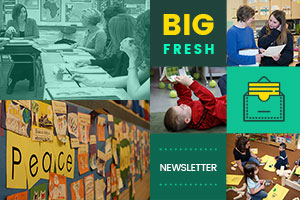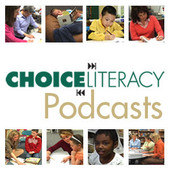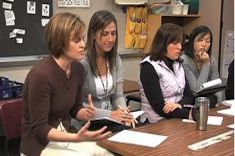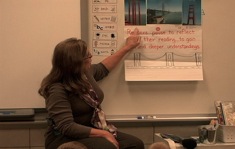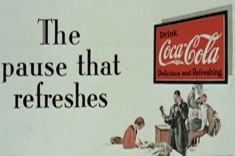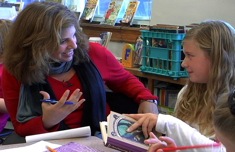Library
Choice Literacy Articles & Videos
The Choice Literacy library contains over 3,000 articles and 900 videos from 150+ contributors. Classic Classroom and Literacy Leadership subscribers have access to the entire library. Content is updated continuously, with five to six new features published each week.
Latest Content
Getting Started with Blogging in Fifth Grade
Katherine Sokolowski presents some strategies from her fifth-grade classroom for launching student blogs.
Celebrating Screen-Free Week (BOOKLIST)
Screen-Free Week is scheduled for May 5-11 this year. Here are some book suggestions to help you explore the issue with students.
The Big Fresh March 29, 2014 Favorites
We present our annual list of your favorite features in this week’s Big Fresh.
A Booklist for Earth Day
Earth Day is celebrated on April 22. Sarah Klim presents some favorite titles to share with students and build awareness in this booklist.
The Big Fresh March 22, 2014 Something Strong, Smart, and Beautiful
Bravery in many forms is the focus of this week’s Big Fresh.
Visiting the Doctor: Conferring with Alexis
Ruth Ayres confers with first grader Alexis about her visit to the doctor for a shot. The conference focuses on illustrations and labeling.
Manipulating Time: Fourth-Grade Writing Minilesson
Tony Keefer uses his writing as a mentor text in this fourth-grade minilesson on manipulating time in personal narratives.
Finding Meaning and Joy in Teaching: A Podcast with Meenoo Rami
In a new podcast, Meenoo Rami talks about ways teachers can bring energy and joy back into their teaching.
Brave Noah
Ruth Ayres tells the story of Noah, a brave first grader with a hard home life who has few happily ever afters as a writer.
The Big Fresh March 15, 2014 Reframing Despair
We look at vocabulary instruction in this week’s Big Fresh.
Mentor Reader: Words
Gigi McAllister writes about a quick activity for modeling word learning and fostering discussion of new vocabulary.
Conferring About Word Learning
Sean Moore teaches second grader Mikhail some strategies for learning words in a conference.
Owl Research Word Study
Andrea Smith leads a whole-class discussion of recording new content vocabulary in reading notebooks.
Expanding the Literacy Classroom with Flipped Minilessons
Katharine Hale tries some flipped minilessons in her fifth-grade classroom and explains how technology is providing new opportunities for student learning.
The Big Fresh March 8, 2014 Reading Dogs
We consider minilesson design in this week’s Big Fresh.
Poemfields
Shirl McPhillips captures beautifully the “hard knuckle” of the end of winter and the slow turn to spring in a new poem and reflection.
Word Observations
Max Brand describes how word observations can work as powerful minilessons in elementary classrooms.
Katie DiCesare on Word Learning (PODCAST)
Katie DiCesare chats with Franki Sibberson about word learning in Katie’s first-grade classroom.
Simplifying Word Study
Max Brand has suggestions for simplifying word study.
Bridge to Comprehension Minilesson
Deb Gaby uses a bridge metaphor in a comprehension minilesson for second graders.
March Literacy Contracts: Nonfiction Curiosities
This month’s literacy contract for middle school students focuses on nonfiction texts and growing independence in the classroom.
The Big Fresh March 1, 2014 Sensing Spring
A fun take on March Madness with book brackets is the focus of this week’s Big Fresh.
Bracketology
Mary Lee Hahn uses bracketology to help her fifth-grade students explore determining importance in short texts and close reading.
Drama and Two-Page Spreads: Conferring with Max
Ruth Ayres confers with second grader Max about the drama of losing his dog, and the value of using two-page spreads to tell a story.
The Big Fresh February 22, 2014 Making Opinions Matter
Opinion and argumentative writing are the focus of this week’s Big Fresh.
The Pause That Refreshes: Write When the Conversation Gets Hot
When’s the best time for some spontaneous opinion writing? Suzy Kaback argues it’s when class conversations get hot.
Writing Fiction: More Than Just a Walk in the Park
Is there room for fiction writing in middle schools in the age of the Common Core? Katie Baydo-Reed shares eight compelling reasons why fiction writing is still essential in her eighth-grade classroom.
Conferring About Lemony Snicket and Vocabulary
Aimee Buckner confers with fourth grader Samantha about reading a series and tackling challenging vocabulary at the same time in this brief video.
So You Think You Can Combine Sentences? You Can!
Heather Rader concludes her series on sentence combining with a four-step process to help teachers explore the sentence combining craft on their own.
The Big Fresh February 15, 2014 Fancy Foods
We explore instruction with series and chapter books in this week’s Big Fresh.
Browse Content By
Type
Category
- Assessment Tools
- Big Fresh Archives
- Booklists
- Choice Numeracy
- Classroom Design
- Common Core
- Community Building
- Conferring
- Content Literacy
- Digital Literacy
- English Language Learners
- Equity
- Family Relations
- Free Samples
- Guiding Groups
- Leadership
- Literacy Coaches
- Mentor Texts
- Minilessons
- New Teacher Mentors
- Podcasts
- Poetry
- Quote Collections
- Reading Strategies
- Self Care
- Struggling and Striving Learners
- Talking and Listening
- Teacher Study Groups
- Teaching Reading
- Teaching Writing
- Word Study and Vocabulary
Author
- Melissa Quimby
- Nawal Qarooni
- Gwen Blumberg
- Julie Cox
- The Lead Learners
- Hannah Tills
- Josie Stewart
- Ruth Metcalfe
- Mallory Messenger
- Becca Burk
- Jodie Bailey
- Vivian Chen
- Mary Brower
- Tiffany Abbott Fuller
- Stephanie Affinito
- Ruth Ayres
- Leigh Anne Eck
- Heather Fisher
- Shari Frost
- Julie Johnson
- Suzy Kaback
- Gigi McAllister
- Shirl McPhillips
- Melanie Meehan
- Cathy Mere
- Debbie Miller
- Tara Barnett and Kate Mills
- Tammy Mulligan
- Dana Murphy
- Bitsy Parks
- David Pittman
- Brenda Power
- Heather Rader
- Matt Renwick
- Mandy Robek
- Christy Rush-Levine
- Gretchen Schroeder
- Jen Schwanke
- Brian Sepe
- Katherine Sokolowski
- Stella Villalba
- Jennifer Vincent
Grade Level
Choice Literacy Membership
Articles
Get full access to all Choice Literacy article content
Videos
Get full access to all Choice Literacy video content
Courses
Access Choice Literacy course curriculum and training



